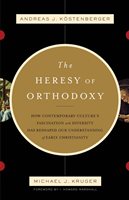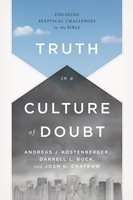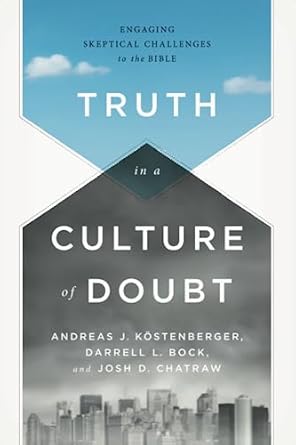Today we continue our interview with Andreas Köstenberger, as he talks to us about Truth in a Culture of Doubt which he co-authored with Darrell Bock and Josh Chatraw. If you missed part one of this interview, you can catch up here.
Books At a Glance (Fred Zaspel):
Explain to us the problem with Ehrman’s appeal to the “scholarly consensus.”
Köstenberger:
Often in the classroom, and also in his writings, Ehrman would say that all his close friends agree with his assessment of God, the Bible, and Jesus, and also virtually all his not-so-close friends. What he typically neglects to point out is that there are many conservative evangelical scholars who offer legitimate, even compelling, explanations for the “problems” he raises with regard to God, Jesus, and the Scriptures. As a matter of fact, my co-authors and I have addressed virtually all of the arguments Ehrman has marshaled in his various writings at considerable length, not only in Truth Matters and Truth in a Culture of Doubt but also in The Heresy of Orthodoxy (co-authored with Michael Kruger).
 So when Ehrman says the “scholarly consensus” is that the Bible can’t be trusted, he’s primarily referring to his brand of critical, if not skeptical, scholarship that says the Bible is merely a product of human religious consciousness rather than revelation that comes from God.
So when Ehrman says the “scholarly consensus” is that the Bible can’t be trusted, he’s primarily referring to his brand of critical, if not skeptical, scholarship that says the Bible is merely a product of human religious consciousness rather than revelation that comes from God.
Books At a Glance:
We don’t have space here to address the question of alleged contradictions in Scripture in detail, but is there perhaps a general way you can characterize Ehrman’s allegations on this score? Perhaps some cautions that can alert us in this regard?
Köstenberger:
Oddly enough, Ehrman is actually quite literalistic (i.e., overly literal) when tackling so-called contradictions in the Bible. He points out, for example, that the first three Gospels call Jesus’ startling works “miracles” while John calls them “signs.” He also alleges that Mark presents Jesus hanging on the cross in utter despair while Luke casts him as in complete control.
In some cases, Ehrman’s observations may have some surface plausibility, but be careful not to jump to conclusions here. In these and all the other examples of so-called contradictions Ehrman cites, there are legitimate ways to account for these differences. The passages he pits against each other are often examples of multiple perspectives that are common with eyewitness reports. Check out Mark and Luke and see if you can’t find places in Mark where Jesus is shown to be in control and passages in Luke where Jesus is shown in agony, and you’ll see that the black-and-white picture with which Ehrman paints the contrast is wildly exaggerated.
Also, in Ehrman’s “fundamentalism” he fails to appreciate the deeper spiritual truths conveyed by a given biblical writer. As we attempt to show in Truth in a Culture of Doubt, in many instances a theological point is being made that Ehrman fails to appreciate, such as when John, by calling Jesus’ miracles “signs,” stresses that people might have been able to see the miracle but still missed the “sign,” that is, the way in which a given work of Jesus pointed to his messianic identity.
 Books At a Glance:
Books At a Glance:
Ehrman makes much of the fact that we don’t have the original manuscripts of Scripture. Would you explain for us why this is not a problem?
Kostenberger:
Because even if we don’t have the originals, we still have the text! Think, for a moment, what would happen if we didn’t have any original copies of the US Constitution, or of the Declaration of Independence. Would we have to sink into utter despair or confusion just because there were no originals? Would we have to conclude that we didn’t know what the Constitution says? No, if we have good, multiple, reliable copies. Now let’s take this example a step further and say the copies of the Constitution we have were to show some minor differences. Would that be a major problem? Again, the answer is no, because we could easily reconstruct on the basis of the existing copies what the original most likely would have read, and the major thrust and the key points would in any case be clear enough.
It’s similar with Scripture: we don’t have the original manuscripts, but we have the TEXT of Scripture in the many, many copies we do have, many of which being in very large agreement on what the text says and none affecting a key doctrine of Scripture.
 Books At a Glance:
Books At a Glance:
Ehrman alleges that the original disciples of Jesus were illiterate, which of course would mean that they did not write books in our New Testament after all. What are the facts here?
Köstenberger:
Well, tax collectors such as Matthew were almost certainly literate. Most fishermen such as John, James, Peter, and Andrew in all probability were literate as well, if for no other reason so they could deal with tax collectors! But Ehrman calls Peter a “backwoods illiterate peasant.” We know that Peter was an extremely capable oral communicator, which means at a minimum that he was very good at expressing himself with words, whether orally or in writing. Even if he was merely a good public speaker who couldn’t write, he could have had someone else (an amanuensis) write down what he said!
Ehrman seems too trapped in a literary model of communication to appreciate that Peter and the other disciples lived in a predominantly oral culture which ought to affect our understanding of ancient “literacy.” Certainly Acts 4:13 can’t be used to support the argument that Peter and John were illiterate, because the word used there to describe them, agrammatoi, means they lacked formal education (they were not grammatoi, that is, formally trained), but says nothing about their ability to read or write. In fact, as we explain in our book, the context makes clear that people were surprised Peter and John were so knowledgeable when they expected them to be ignorant, not the other way around!
 Books At a Glance:
Books At a Glance:
You mention that, ironically, there are ways in which Bart Ehrman has done us a favor – how is that so?
Köstenberger:
Well, he has raised some of the key questions we need to be able to knowledgeably address in defending our faith. He is smart enough to know that in his quest to discredit the Christian faith, he needs to focus on the central elements of Christianity: the existence and character of God, the divinity of Jesus, the reliability of the Scriptures. So he’s done us the favor of bringing these key issues into the public limelight so we can offer credible answers and alternatives to his skeptical take on all these questions.
Books At a Glance:
How did you, Darrell Bock, and Josh Chatraw come to team up and work together on these books?
Köstenberger:
Well, that’s an interesting story. Josh, who was one of my doctoral students at Southeastern, mentioned to me that he thought it would be important to provide a response to some of the arguments of Bart Ehrman. Roughly around that same time, I attended a debate between Ehrman and Wallace which stirred in me the desire to provide a more compelling response to Ehrman’s arguments on a wide variety of topics as well. I presented the idea to B&H Academic, and after several revisions of our proposal, they decided to publish our book. To add more power and persuasion to our lineup, we decided to ask Darrell Bock if he wanted to join us in this endeavor, and he quickly agreed. As the director for the center of cultural engagement at Dallas Seminary, Darrell has developed a growing burden to engage the larger culture on matters of faith, and so he welcomed Truth Matters as an excellent opportunity to make a case for the reliability of Scripture. After we submitted our manuscript, LifeWay decided to go mainstream with our book and to publish both a popular version (Truth Matters) and a sequel setting out our case in more detail (Truth in a Culture of Doubt).
*Note: For more on the work of Darrell Bock, Josh Chatraw, Andreas Köstenberger, and Michael Kruger on these subjects, see here and here. You can catch up on Part 1 of this interview here.

